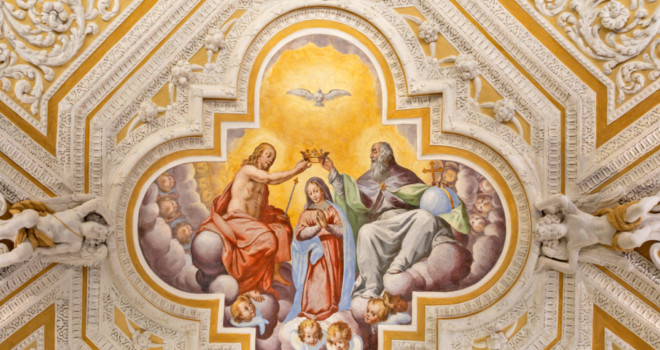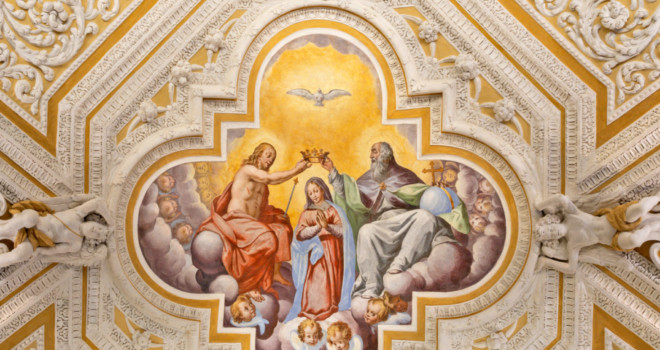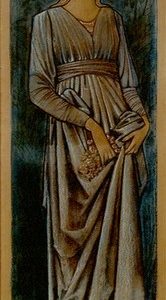The dogma of the Assumption declares that at the conclusion of her earthly life, Mary’s body was preserved from all physical corruption and assumed, along with her soul, into heaven. The doctrine of the Assumption was made a dogma in 1950 through an ex cathedra statement by Pope Pius XII, but the teaching itself, as with all dogmas, goes back to the Bible and the traditions of the early Church.
The first hint of Mary’s Assumption comes once more from Genesis 3:15. There we see the mother of the redeemer, sharing in her son’s victory over evil: “I will put enmity between you and the woman and between your seed and her seed. . .” What does that have to do with the Assumption, you ask?
Well, if you flip ahead in your Bible, you’ll see that in Romans 5-8 and Hebrews 2, St. Paul tells us that the effects of evil, of Satan’s seed, are twofold: sin first, the corruption of death second. Mary’s sharing in her son’s victory over evil, therefore, means that she would, like her son, be free from all stain of sin and escape the fate of bodily corruption after death. By preserving her from sin at conception, God gave Mary the amazing privilege of being born with a fullness of grace. And in the Assumption, the fitting bookend to the Immaculate Conception, her body was spared from the ravages of corruption.
More biblical support for the teaching comes from Luke 1:28, since Mary’s bodily Assumption would be a natural effect of being “full of grace”; and furthermore, from Revelation 12:1, where Mary appears in heaven, crowned with the sun. Importantly, Mary’s appearance comes immediately after St. John tells us that the Ark of the Covenant has appeared in the heavens; remember that the Ark was one of the first Christians’ most common metaphors for Mary, who, just as the Ark had done, carried the presence of God within her.
It shouldn’t surprise you by now to hear that the early Church believed in this dogma. In the early fourth century, not long after Christianity became legal in the Roman Empire and it became possible to build public places of worship, the Christians in Rome built a grand church in Mary’s honor. Today, that church is known as the Basilica of St. Mary Major. In that church, constructed in approximately 360 AD, is a historical testimony to the early belief in Mary’s Assumption: a fresco depicting the mother of Jesus being lifted up to heaven by the angels.
In the sixth century, St. Gregory of Tours wrote, “The Lord commanded the holy body [of Mary] to be borne on a cloud to paradise, where, reunited to its soul and exalting with the elect, it enjoys the everlasting bliss of eternity.” From the seventh century onward, numerous Church Fathers, including St. Germaine of Constantinople (d. 733), St. Andrew of Crete (d. 740), and St. John Damascene (d. 749) wrote and preached about the Assumption.
During the sixth century, the first liturgical feasts dedicated to the Assumption appeared in Syria and Egypt. Western liturgical feasts celebrating the Assumption began taking place in Gaul (modern-day France) in the seventh century, and by the eighth century, it was celebrated in Rome. From the thirteenth century on, the doctrine of Mary’s Assumption was being universally celebrated throughout the Church in both the East and the West.
When Pius XII declared Mary’s Assumption an official dogma of the Church, he pointed out that there are essential connections between the Assumption and the other Marian dogmas, particularly the Motherhood of God and the Immaculate Conception.
Mary’s Assumption is the logical effect of her being preserved from Original Sin. Adam and Eve would likewise have been assumed, uncorrupted, at the end of their earthly lives. Mary, the new Eve, enjoyed what the first Eve lost through sin.
Pope Pius also remarked how appropriate it was that Jesus chose to honor his mother as only a divine son could. Jesus perfectly fulfilled the Jewish Law, including the Ten Commandments. Included in those commandments, number four on the list, is “Honor thy father and mother.” Because perfectly fulfilling the law meant perfectly honoring his mother, it makes sense that Jesus would uniquely honor his mother, first, by preserving her from the corruption of the grave and second, by granting her glorification of the body in heaven before the general resurrection of the body for all other saints on the last day. After all, who among us, if it were in our power, would do less for our own mothers?
Another question that often arises in connection with the Assumption is this: Did Mary die? Well, the Church has never definitively said one way or the other. The majority of Catholic and Eastern Orthodox theologians, however, do think it likely that at the end of her earthly life, Mary did die, and by die, we mean a temporary separation of the soul and body, in which the body suffers no manner of bodily decay. Her death, however, must have occurred in circumstances beyond our ordinary human experience. Mary did not die as most of us do, from disease or from mortal aging. This would not be possible in light of her Immaculate Conception, which safeguarded her from the punishments revealed in Genesis due to sin, including death and decay.
Her body would not experience decay, before or after death, because bodily corruption was an effect of the Fall, and Mary’s Immaculate Conception would prevent her from the punishment of bodily breakdown. Her death is, like her Assumption, fitting, because, as the model of the perfect disciple, she would have wished to imitate her Son in all things, including death.
Mary Radiates the Splendor of the Lord
How beautifully and appropriately does the life and truth of the mother radiate the splendor and the glory of the son! Her divine motherhood enfleshes our redeemer as a God who loved us so much that he truly becomes one of us to save us. Her virginity reveals his divine and heavenly origins and exemplifies Mary’s perfect discipleship to Jesus. Her Immaculate Conception is the greatest fruit of his glorious Redemption and brings our savior into the world in complete separation from the evil one. And her Assumption foreshadows the ending victory of each person who accepts Jesus as Lord, in word or in charity.
These four central dogmas of Jesus’ mother — her divine motherhood, her perpetual virginity, her Immaculate Conception, and her Assumption — reveal the unique role Mary of Nazareth played in God’s plan of salvation. However, they also point to how Mary continues to play an important role in the life of the Church and of all believers.
✠












